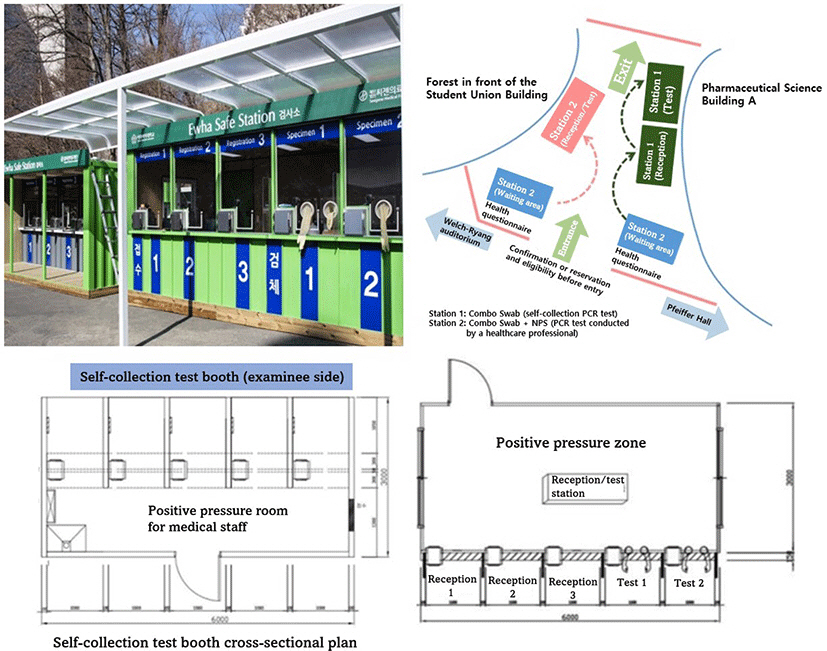Ewha Med J.
2022 Oct;45(4):e18. 10.12771/emj.2022.e18.
The COVID-19 Pandemic Response System at University Level: The Case of Safe Campus Model at Ewha Womans University
- Affiliations
-
- 1Department of Environmental Medicine, College of Medicine, Ewha Womans University, Seoul, Korea
- 2Clinical Research Institute, Seegene Medical Foundation, Seoul, Korea
- 3Laboratory Medicine Center, Seegene Medical Foundation, Seoul, Korea
- 4Department of Marketing, Seegene Medical Foundation, Seoul, Korea
- 5Department of Internal Medicine, College of Medicine, Ewha Womans University, Seoul, Korea
- 6Department of Health Convergence, College of Science and Industry Convergence, Ewha Womans University, Seoul, Korea
- 7Graduate Program in System Health Science and Engineering, Ewha Womans University, Ewha Medical Research Institute, College of Medicine, Seoul, Korea
- 8School of Biomedical Convergence Engineering, Pusan National University, Yangsan, Korea
- 9Department of Preventive Medicine, College of Medicine, Ewha Womans University, Seoul, Korea
- KMID: 2534744
- DOI: http://doi.org/10.12771/emj.2022.e18
Abstract
- In response to the changes in the Coronavirus disease 2019 (COVID-19) epidemic situation, Ewha Womans University established Ewha Safe Campus (ESC), an on-campus infection outbreak management system, to allow students and faculty members to safely resume face-to face classes in 2022. The COVID-19 testing station, Ewha Safe Station, is the core element of ESC. Symptomatic students and faculty members perform a combo swab self-PCR test or receive a nasopharyngeal swab PCR test from experts to prevent the spread of COVID-19 through early detection and management. ESC is significant in that it detects infection risks and proactively implements preemptive measures in a university. The COVID-19 health response system model at the university level was applied for the first time in South Korea, reaching a milestone in the history of university health in South Korea. In particular, it is highly valuable that the test was free of charge, as it enabled all of the examinees to have easy access to the test through joint cooperation with the Seegene Medical Foundation. This is a successful example of cooperation between schools and private institutions for public health improvement. In the future, the direct and indirect effects of the establishment and implementation of ESC need to be evaluated and confirmed, and areas requiring improvements need to be identified in preparation for another infectious disease outbreak in the future.
Keyword
Figure
Reference
-
References
1. World Health Organization. Timeline: WHO's COVID-19 response [Internet]. Geneva (CH): World Health Organization;c2022. cited 2022 Sep 23. Available from. https://www.who.int/emergencies/diseases/novel-coronavirus-2019/interactive-timeline.2. World Health Organization. WHO COVID-19 dashboard [Internet]. Geneva (CH): World Health Organization;c2020. cited 2022 Sep 23. Available from. https://covid19.who.int/.3. Korea Disease Control and Prevention Agency. Public Health Weekly Report: Korea Disease Control and Prevention Agency [Internet]. Cheongju (KR): Korea Disease Control and Prevention Agency;c2022. cited 2022 Sep 23. Available from. https://www.kdca.go.kr/board/board.es?mid=a30501000000&bid=0031&cg_code=C06.4. Korea Disease Control and Prevention Agency. COVID-19 [Internet]. Cheongju (KR): Korea Disease Control and Prevention Agency;c2019. cited 2022 Jan 31. Available from. https://ncov.kdca.go.kr/bdBoardList_Real.do?brdId=1&brdGubun=11&ncvContSeq=&contSeq=&board_id=&gubun=.5. Ministry of Education. Ministry of Education [Internet]. Sejong (KR): Ministry of Education;;c2022. cited 2022 Oct 13. Available from. https://www.moe.go.kr/boardCnts/viewRenew.do?boardID=294&boardSeq=90598&lev=0&searchType=null&statusYN=W&page=30&s=moe&m=020402&opType=N.6. Lee RA, Herigon JC, Benedetti A, Pollock NR, Denkinger CM. Performance of saliva, oropharyngeal swabs, and nasal swabs for SARS-CoV-2 molecular detection: a systematic review and meta-analysis. J Clin Microbiol 2021. 59(5):e02881–20. DOI: 10.1128/JCM.02881-20. PMID: 33504593. PMCID: PMC8091856.7. Nasiri K, Dimitrova A. Comparing saliva and nasopharyngeal swab specimens in the detection of COVID-19: a systematic review and meta-analysis. J Dent Sci. 2021; 16(3):799–805. DOI: 10.1016/j.jds.2021.01.010. PMID: 33558826. PMCID: PMC7846225.
Article8. Takeuchi Y, Furuchi M, Kamimoto A, Honda K, Matsumura H, Kobayashi R. Saliva-based PCR tests for SARS-CoV-2 detection. J Oral Sci. 2020; 62(3):350–351. DOI: 10.2334/josnusd.20-0267. PMID: 32581183.
Article9. Moraleda C, Domínguez-Rodríguez S, Mesa JM, García-Sánchez P, de la Serna M, Alonso-Cadenas JA, et al. Oral saliva swab reverse transcription PCR for Covid-19 in the paediatric population. Arch Dis Child. 2022; 1–8. DOI: 10.1136/archdischild-2021-323712. PMID: 35688603. PMCID: PMC9240444.10. Wehrhahn MC, Robson J, Brown S, Bursle E, Byrne S, New D, et al. Self-collection: An appropriate alternative during the SARS-CoV-2 pandemic. J Clin Virol. 2020; 128:104417. DOI: 10.1016/j.jcv.2020.104417. PMID: 32403007. PMCID: PMC7198188.11. Salvatore PP, Sula E, Coyle JP, Caruso E, Smith AR, Levine RS, et al. Recent increase in COVID-19 cases reported among adults aged 18–22 years — United States, May 31–September 5, 2020. MMWR Morb Mortal Wkly Rep. 2020; 69(39):1419–1424. DOI: 10.15585/mmwr.mm6939e4. PMID: 33006586. PMCID: PMC7537557.
Article
- Full Text Links
- Actions
-
Cited
- CITED
-
- Close
- Share
- Similar articles
-
- A Proactive Testing Strategy to COVID-19 for Reopening University Campus during Omicron Wave in Korea: Ewha Safe Campus (ESC) Project
- Influence of the COVID-19 Pandemic on the Treatment Patterns and Outcomes of Colorectal Cancer
- The coronavirus disease 2019 pandemic and chronic diseases
- Changes in eating behaviors according to household income in adolescents during the COVID-19 pandemic: findings from the Korea National Health and Nutrition Examination Survey
- Vision of Ewha in the COVID-19 Pandemic Era: A Note from the President


